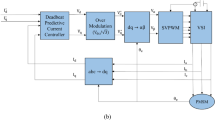Abstract
To solve the problem that the switched reluctance motor (SRM) may have harmful impact on the shaft during the starting process, a half-S soft starting control method is proposed. The switch signal is given based on the discrete position signal of SRM without the requirement of accurate rotor position information. In the process of the motor from static to rotation, the current step chopping soft starting is adopted to prevent the phase current from flowing; In starting acceleration stage, the edge signal of discrete position is used as the control period. By using sliding mode control, the increment of the rotation speed is identical at each position signal interval. The speed increased exponentially within the rated output power of motor. Through using Matlab/Simulink environment and switched reluctance motor drive platform, this method was validated, and the results reveals that the proposed method is able to achieve smooth starting and reduce the harmful impact on the mechanical system which shows high application value in the development field of SRM type electric vehicle.













Similar content being viewed by others
References
Shoujun, S., Lefei, G., Hucheng, L., et al.: Design and multi-objective optimization method of switched reluctance machines. Trans. China Electrotech. Soc. 29(5), 197–204 (2014)
Vijayakumar, K., Karthikeyan, R., Paramasivam, S., et al.: Switched reluctance motor modelling, design, simula-tion, and analysis: a comprehensive review. IEEE Trans. Magn. 44(12), 4605–4617 (2008)
Kano, Y., Kosaka, T., Matsui, N.: Optimum design approach for a two-phase switched reluctance compressor drive. IEEE Trans. Ind. Appl. 46(3), 955–964 (2010)
Raminosoa, T., Blunier, B., Fodorean, D., et al.: Design and optimization of a switched reluctance motor driving a compressor for a PEM fuel-cell system for automotive applications. IEEE Trans. Ind. Electron. 57(9), 2988–2997 (2010)
Yinping, F.: Research on optimization design ofswitched reluctance motor. Coal Technol. 30(12), 258–259 (2011)
Xiaoshu, Z., Hao, C.: Study on the starting performance of switched reluctance starter generator system. Trans. China Electrotech. Soc. 30(20), 21–30 (2015)
Yang, Y., Zhang, Y., Wang, S.: Studyon starting performance of SRM by electric vehicle. J. Beijing Jiaotong Univ. 31(5), 114–116 (2007)
Wang, S., Yang, Y.: Starting performance of switched reluctance motor for electric traction. Electr. Mach. Control Appl. 34(10), 51–56 (2007)
Dean, Z., Fei, Z., Li, Q., et al.: Switched reluctance motor for integrated starter alternator driver system of vehicles. J. Nanjing Univ. Aeronaut. Astronaut. 40(6), 825–830 (2008)
Liu, C.: Theoretical Research and Engineering Practice of Switched Reluctance Motor Starter/Generator System. Nanjing University of Aeronautics and Astronautics, Nanjing (2000)
Fan, Y., Zhu, X.: Research on switched reluctance motor starting with constant acceleration. Mech. Electr. Eng. Mag. 31(2), 208–212 (2014)
Wu, H.: Theory and Control Technology of Switched Reluctance Motor. China Electric Power Press, Beijing (2010)
Miller, J.M., McCleer, P.J., Lang, J.H.: Starter-alternator for hybrid electric vehicle-comparison of induction and variable reluctance machines and drives. IEEE 1, 513–523 (1998)
Xue, X.D., Cheng, K.W.E., Ho, S.L.: Study of power factor in SRM drives under current hysteresis chopping control. In: Conference Record of the Industry Applications Conference, vo1. 4, pp. 2734–2740 (2005)
Hao, R.-K., Wu, R., Zhu, J., et al.: Research on the starting performance of SR motor. In: 2010 International Conference on Electrical and Control Engineering (ICECE), pp. 4168–4171 (2010)
Hamed, S.A.: Analysis of variable-voltage thyristor controlled induction motors. IEE Proc. 137(3), 184–193 (1990)
Sun, J., Fang, J., Wang, J.: Oscillation in soft-starting of induction motor. Trans. China Electrotech. Soc. 22(2), 15–21 (2007)
Zenginobuz, G., Cadirci, I., et al.: Performance optimization of induction motors during voltage-controlled soft starting. IEEE Trans. Energy Convers. 19(2), 278–288 (2003)
Vujiicic, V.P.: Modeling of a switched reluctance machine based on the invertible torque function. IEEE Trans. Magn. 44(9), 2186–2194 (2008)
Li, Y., Bai, L.: The performance optimization in SR motor control through angular sub-division. In: 2010 International Conference on Measuring Technology and Mechatronics Automation (ICMTMA), pp. 933–936 (2010)
Yuan, P., Zhang, W.: Application of improved M/T method in motor speed measurement. Light Ind. Mach. 30(1), 59–62 (2012)
Sun, T., Xu, D.: A variable M/T speed measurement method with single-chip processor and its application. Electr. Drive Autom. 19(4), 57–59 (1997)
Li, M., Li, Y.: Switched reluctance motor control simulation based on VSS. Comput. Simul. 26(12), 351–355 (2009)
Huang, C., Zhang, Y.: Variable-structure control of switched reluctance motor. Electr. Power Autom. Equip. 26(12), 35–37 (2006)
Changfan, Z., Yaonan, W.: An intelligent control using sliding mode variable structure and its application. Proc. CSEE 21(3), 27–29 (2001)
Li, X., Zhao, C., Xiao, L., et al.: Split ranging control method based on pseudo-sliding mode algorithm for cascaded DVR system. Proc. CSEE 27(21), 106–111 (2007)
Acknowledgements
This work was supported by open Fund of Jiangsu Province Natural Science Foundation (Nos. BK20140649, BE2016805), National Natural Science Foundation (Nos. 61503081, 61473079) and Science For Earthquake Resilience (No. XH171001).
Author information
Authors and Affiliations
Corresponding author
Rights and permissions
About this article
Cite this article
Zhang, G., Wang, L., Huang, Y. et al. Half-soft starting control of switched reluctance motor using discrete position signal processing. Cluster Comput 20, 3185–3198 (2017). https://doi.org/10.1007/s10586-017-1041-y
Received:
Revised:
Accepted:
Published:
Issue Date:
DOI: https://doi.org/10.1007/s10586-017-1041-y




